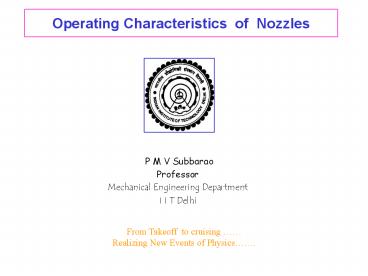Operating Characteristics of Nozzles - PowerPoint PPT Presentation
1 / 32
Title:
Operating Characteristics of Nozzles
Description:
Operating Characteristics of Nozzles P M V Subbarao Professor Mechanical Engineering Department I I T Delhi From Takeoff to cruising Realizing New Events of ... – PowerPoint PPT presentation
Number of Views:67
Avg rating:3.0/5.0
Title: Operating Characteristics of Nozzles
1
Operating Characteristics of Nozzles
- P M V Subbarao
- Professor
- Mechanical Engineering Department
- I I T Delhi
From Takeoff to cruising Realizing New Events
of Physics.
2
Converging Nozzle
pb Back Pressure
Design Variables
Outlet Condition
p0
pb
3
Designed Exit Conditions
Under design conditions the pressure at the exit
plane of the nozzle is applied back pressure.
4
Profile of the Nozzle
At design Conditions
5
Full Capacity Convergent Nozzle
6
Remarks on Isentropic Nozzle Design
- Length of the nozzle is immaterial for an
isentropic nozzle. - Strength requirements of nozzle material may
decide the nozzle length. - Either Mach number variation or Area variation or
Pressure variation is specified as a function or
arbitrary length unit. - Nozzle design attains maximum capacity when the
exit Mach number is unity.
7
Converging Nozzle
p0
Pb,critical
8
Operational Characteristics of Nozzles
- A variable area passage designed to accelerate
the a gas flow is considered for study. - The concern here is with the effect of changes in
the upstream and downstream pressures - on the nature of the inside flow and
- on the mass flow rate through a nozzle.
- Four different cases considered for analysis are
- Converging nozzle with constant upstream
conditions. - Converging-diverging nozzle with constant
upstream conditions. - Converging nozzle with constant downstream
conditions. - Converging-diverging nozzle with constant
downstream conditions.
9
Pressure Distribution in Under Expanded Nozzle
pbp0
p0
pb,criticalltpb1ltp0
Pb,critical
At all the above conditions, the pressure at the
exit plane of nozzle, pexit pb.
10
Variation of Mass Flow Rate in Exit Pressure
1
1
11
Variation of in Exit Pressure
1
1
12
Variation of in Mass Flow Rate
1
13
Low Back Pressure Operation
14
Convergent-Divergent Nozzle Under Design
Conditions
15
(No Transcript)
16
Convergent-Divergent Nozzle with High Back
Pressure
plt pb1ltp0
pthroatgt p
17
Convergent-Divergent Nozzle with High Back
Pressure
- When pb is very nearly the same as p0 the flow
remains subsonic throughout. - The flow in the nozzle is then similar to that in
a venturi. - The local pressure drops from p0 to a minimum
value at the throat, pthroat , which is greater
than p. - The local pressure increases from throat to exit
plane of the nozzle. - The pressure at the exit plate of the nozzle is
equal to the back pressure. - This trend will continue for a particular value
of back pressure.
18
Convergent-Divergent Nozzle with High Back
Pressure
At all these back pressures the exit plane
pressure is equal to the back pressure.
pthroatgt p
19
(No Transcript)
20
(No Transcript)
21
(No Transcript)
22
At exit with high back pressure pb
At throat with high back pressure pb
23
- For a given value of high back pressure
corresponding throat pressure can be calculated. - As exit area is higher than throat area throat
pressure is always less than exit plane pressure. - An decreasing exit pressure produces lowering
throat pressure
24
Variation of Mass Flow Rate in Exit Pressure
1
1
25
Variation of in Mass Flow Rate
1
26
Numerical Solution for Mach Number Caluculation
Use Newtons Method to extract numerical
solution
Define
At correct Mach number (for given A/A)
Expand F(M) is Taylors series about some
arbitrary Mach number M(j)
27
(No Transcript)
28
Solve for M
29
Still exact expression
if M(j) is chosen to be close to M
And we can truncate after the first order terms
with little Loss of accuracy
30
First Order approximation of solution for M
Hat indicates that solution is no longer exact
However one would anticipate that
estimate is closer than original guess
31
And we would anticipate that
refined estimate . Iteration 1
32
Abstracting to a jth iteration
Iterate until convergence j0,1,.
Drop from loop when































